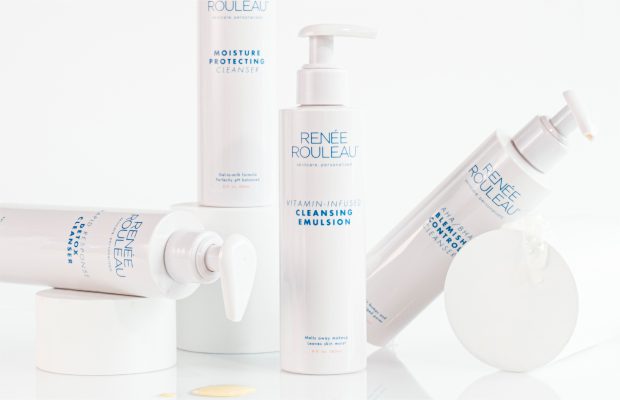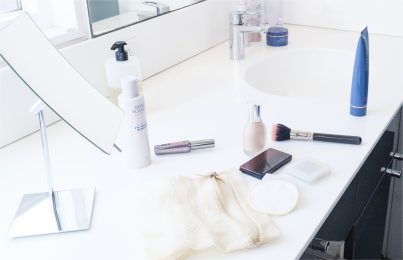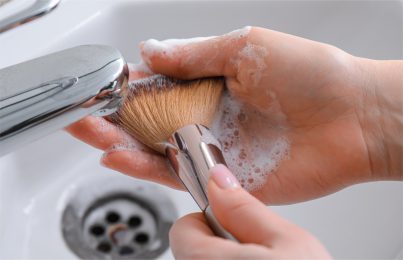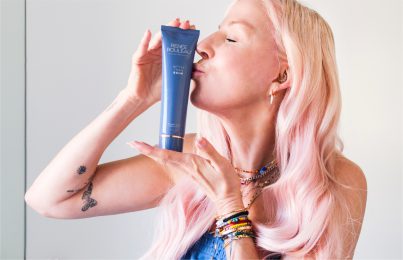You already know that properly cleansing your skin is the foundation of any good skincare routine. Twice-daily cleansing keeps our skin healthy in a number of ways. It helps prevent clogged pores and breakouts by removing excess oil; it slows down visible signs of aging by rinsing away pollution and debris; finally, it helps maintain balanced, hydrated skin by gently sloughing off dead cell build-up.
Seems straightforward enough, but with so many different types of cleansers available, how do you choose the right one for your skin type? While all cleansers generally serve the same basic purpose—to remove dirt, oil, makeup, and other debris—different formulas have different benefits. Knowing which one to use (and when to use it!) can make all the difference in your skin.
Gel Cleansers
Of the cleansers mentioned in this post, gel cleansers are the most straightforward. When the average person thinks of a face cleanser, this is probably what they’re imagining. The reason I say gel cleansers are the most straightforward is that they all have the same two, basic components—water and surfactants.
Surfactants (an abbreviation for “surface active agent”) are molecules with a water-loving head and an oil-loving tail. This characteristic allows them to form little spheres that break up and grab oil and dirt that’s sitting on the surface of your skin so that it can be easily rinsed away.
Who Should Use Gel Cleansers
Anyone can use a gel cleanser, but how often you use it depends on your skin type.
I recommend that almost everyone use a gel cleanser to wash their face in the morning. (And yes, you should definitely be washing your face in the morning.) At this point in the day, you’re not really trying to remove sunscreen or makeup from the skin. You just want to get rid of any oil or sweat that accumulated while you were sleeping. This will give you a clean canvas so your morning skincare routine is more effective (especially your sunscreen).
Sometimes, people with dry skin types (like Skin Types 7-9) claim that washing their face in the morning dries out their skin. The key is using a cleanser free of drying sulfates, such as sodium lauryl sulfate. It also helps to use a cleanser that includes hydrating ingredients. For instance, Moisture Protecting Cleanser has glycerin to maintain moisture levels in the skin.
If you consistently struggle with excess oil production, like Skin Types 1-4, you can use a gel cleanser both morning and night. The key is looking for a cleanser with active ingredients that support your skin’s specific needs. For instance, both AHA/BHA Blemish Control Cleanser and Purifying Face Wash contain acne-fighting or pore-purifying ingredients.
How to Use Gel Cleansers
Since gel cleansers cleanse the skin strictly through the use of surfactants, they have to be applied to wet skin in order to work. This gives the water-loving ends of the surfactants something to attach to and essentially activates the cleanser.
Dispense a nickel-sized amount of gel cleanser into your hand and apply it to wet skin. Massage the cleanser onto your skin for 30 seconds, and don’t forget all those hard-to-reach nooks and crannies! Rinse the cleanser off your skin with lukewarm water, then move on to your next skincare step.
Btw, this is how much of each skincare product you should be using.
Lotion Cleansers
As the name suggests, lotion cleansers are cleansers with a lotion-like consistency. They’re structurally very similar to regular moisturizing lotions but with the addition of surfactants for added cleansing ability.
One key difference between lotion and gel cleansers is that lotion cleansers are formulated using emulsifiers. Since these cleansers contain both oil and water-based ingredients, emulsifiers are needed in order for these otherwise incompatible ingredients to be effectively combined in the same formula. Emulsifiers are, in and of themselves, a type of surfactant. Even though they’re not necessarily classified as a “cleansing surfactant,” they do provide some additional cleansing abilities. So, cleansing lotions clean your skin with a combination of both classic surfactants and emulsifiers.
Who Should Use Lotion Cleansers
Lotion cleansers are a great nighttime cleansing option for combination or dry skin types, like Skin Types 5-9. Because they contain oils (unlike gel cleansers), they’re good for taking off your daily sunscreen and light makeup, like a tinted moisturizer. They also deposit a little more moisture onto the skin than gel cleansers, which is why they’re so suitable for drier skin types.
If your skin is on the dry side and in need of some nourishment, check out the Vitamin-Infused Cleansing Emulsion.
How to Use Lotion Cleansers
Begin by dispensing about a quarter-sized dollop of cleanser onto your fingertips, then massage the cleanser onto dry skin. This will allow the oils in the formula to work on dissolving the oils in your sunscreen or makeup. After 30 seconds, add a little water and massage again to activate the surfactants in the cleanser. Rinse your face with lukewarm water, then finish by gently wiping the skin with a damp, soft cloth to lift away every last trace of makeup and sunscreen.
“Cold” Cream Cleansers
Cream cleansers, sometimes referred to as cold creams, are strictly an emulsion of water and very heavy oil-based ingredients like lanolin, beeswax, or mineral oil. Basically, they’re a lotion cleanser on steroids, except they don’t contain any surfactants so they don’t rinse off as easily. This means they rely entirely on their emulsifiers to break down oils on your skin.
Who Should Use Cream Cleansers
Because cream cleansers use heavy, oil-based ingredients, they’re great at removing silicones often found in heavier makeup (think long-wear foundation). That said, they’re not as good at removing dirt and debris from the skin since they’re typically not rinsed off at the end.
Truth be told, I’m not a big fan of cream cleansers because they can deposit a fair amount of oil onto the skin. If you apply the rest of your skincare products on top of this oil, they’ll have a hard time penetrating and won’t be very effective. I know it can be tempting to use such a rich product if your skin is dry, but I prefer to let cleansers do the cleansing and to let nourishing moisturizers, like Skin Recovery Balm, do the moisturizing.
I would only recommend using a cold cream if you have very dry skin and aren’t prone to clogged pores, or if you’re trying to remove heavy makeup. Keep reading for my tips on how to minimize the amount of oil deposited on your skin.
How to Use Cream Cleansers
Instructions for how to use a cold cream can vary slightly depending on the brand, but they all start with a thin layer being applied to dry skin. Massage thoroughly for 30 to 60 seconds to break down makeup, sunscreen, and oil.
This is where the instructions start to vary. Traditionally, you were meant to use a tissue to simply dab off the excess product. I don’t love this method, because it doesn’t really lift off any of the makeup or oil you just dissolved. Instead, you’ve basically just loosened it and then smeared it all over your skin. As I mentioned, it also leaves a fair amount of oil behind on your face, which will make your other skincare products a lot less effective.
Instead, I recommend using the same method you would use with a cleansing lotion. Using a soft, damp cloth will help lift off loosened makeup and debris, plus it will reduce the amount of oil left behind on your skin. If you’re prone to clogged pores, I recommend double-cleansing. Once you’ve removed your makeup with a cold cream, use a gel cleanser to cut through any lingering oil.
Cleansing Balms
Cleansing balms are a popular method of makeup removal these days. The concept is similar to that of a cold cream, but there are two key differences. First, cleansing balms usually do contain some type of surfactant to (theoretically) help them wash off. Second, in addition to being made up of oils, they often included waxes, which is what gives them a solid consistency.
Here’s the catch. The ratio of surfactant to oils and waxes usually isn’t high enough for balms to easily emulsify and rinse off the skin. In fact, these waxes can leave behind a film or residue—even when you double cleanse. I was never been a fan of traditional cleansing balms for the same reason I don’t like cold creams. That residue can result in clogged pores, and it impedes the rest of your skincare products, like serums, from properly penetrating.
With that said, balms are still a really effective way to remove heavy makeup or waterproof sunscreen (and if you wear these things, it’s important to properly remove them!). The good news is that, more recently, a newer generation of cleansing balms has started to emerge. I formulated Better Than Balm with lightweight oils and a higher amount of surfactants to reap all the benefits of a cleansing balm without any of the drawbacks.
Who Should Use Cleansing Balms
I recommend using a cleansing balm if you’re someone who regularly wears foundation makeup or other heavy makeup products. Even if you only wear a full face on special occasions, it can be handy to have a balm around to take it all off. If you’re prone to clogged pores and blemishes, tread carefully. It’s important to choose a cleansing balm like Better Than Balm that’s well-formulated and doesn’t use too many heavy waxes.
I only recommend using a cleansing balm at night since you don’t have makeup or sunscreen to remove in the mornings.
How to Use Cleansing Balms
To start, apply the cleanser to dry skin and gently massage over the face for a full 30 seconds. This will start to dissolve makeup, sunscreen, and sebum. For heavier makeup, such as long-wear or full-coverage foundation, massage for 60 seconds.
Using your fingertips, add water to transform the cleanser into a milky gel. Massage for another 30 seconds or, for heavier makeup, another 60 seconds. Rinse your face with lukewarm water to remove the bulk of the cleanser and makeup. Finally, finish by using a slightly damp cloth like the Reusable Cleansing Cloths, and gently wipe across your face to remove every last trace of loosened makeup and debris.
I hope this post helps shed some light on the different types of cleansers and gives you the information you need to make the right decision for your skin!
Next up, 9 surprising cleansing mistakes you could be making.
Celebrity Esthetician & Skincare Expert
As an esthetician trained in cosmetic chemistry, Renée Rouleau has spent 30 years researching skin, educating her audience, and building an award-winning line of products. Her hands-on experience as an esthetician and trusted skin care expert has created a real-world solution — products that are formulated for nine different types of skin so your face will get exactly what it needs to look and feel its best. Trusted by celebrities, editors, bloggers, and skincare obsessives around the globe, her vast real-world knowledge and constant research are why Marie Claire calls her “the most passionate skin practitioner we know.”




Comments:
The Luxe Mint Cleansing Gel is the best. It really does wake up the skin by giving it a nice glow. This morning I accidently included my lips in cleansing and it gave them a nice pink flush. I don’t think this is recommended by RR but it certainly didn’t cause an irritation. What I was using in the past did a fairly decent job but it didn’t leave my skin glowing. I must suggest that a little goes a long way so I expect this to last for quite awhile.
Posted By: shelley weyand |
Yes, our website accepts international orders and shipping is $15.50 USD.
Posted By: Renée Rouleau |
Hi there, can you tell me if you ship to Ireland?
Posted By: Malvina Barrett |